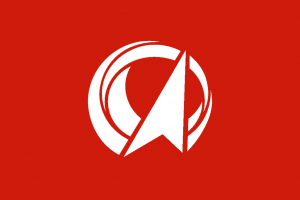BY LETTER
Mars
Galactography > Regions of Space > Inner Sphere
Galactography > Other Major Polities, Empires, and Meta-Empires > Solar Organisation
Galactography > Other Major Polities, Empires, and Meta-Empires > Solar Organisation
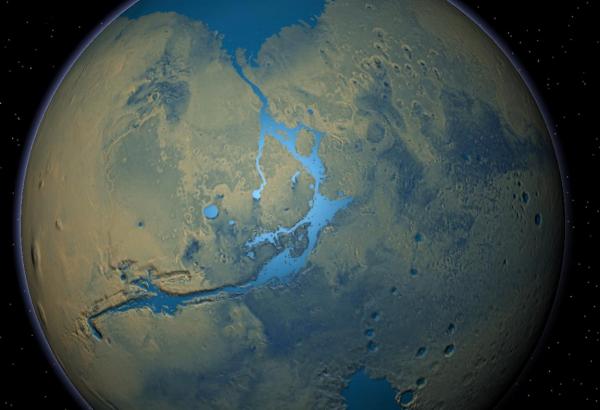 Image from Steve Bowers | |
| Green Mars (without clouds). The pressure in 4500 AT reached 600 millibars, at that point the inhabitants of Mars decided not to fully terraform their world, since the entire surface population had been genetically modified to thrive in the conditions prevailing at the time. Carbon Dioxide levels on this world are high, and may be dangerous to unmodified humans; nitrogen levels are comparatively low, despite many thousands of years of N2 imports. Oxygen levels at the datum altitute are comparable to those at sea-level on Earth. Since 4500 the pressure has increased slightly, as the warming crust has outgassed volatiles over time; but the pressure is not likely to rise any higher than 700 millibars | |
Mars - Data Panel | |
| System | Solsys |
|---|---|
| Planet: | Mars, Sol IV |
| Planet Type: | EuArean Subtype, partially terraformed |
| Distance from Primary: | 1.52 AU |
| Diameter: | 6794 km |
| Density: | 3.94 gm/cm3 |
| Gravity: | 0.379 G |
| Day Year: | 24.6 hours / 686.98 days |
| Axial Tilt: | 25.19° |
| Satellites: | Little remains of the original Phobos and Deimos; much of the mass of Deimos remains as an anchor for the space elevator (see below) |
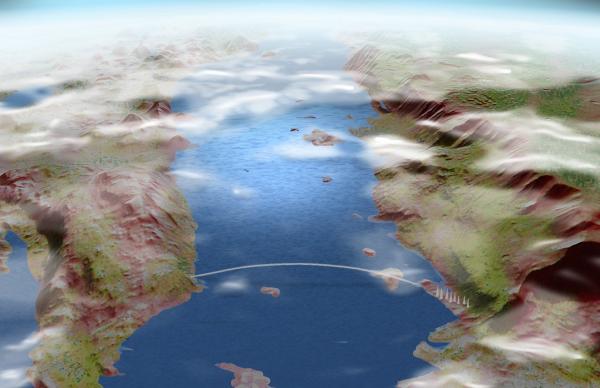 Image from Steve Bowers | |
| The Great Canyon Bridge over the Valles Marineris Sea is supported by mass-stream technology | |
| Atmosphere: | Original: 0.007 atm (CO2, N2) Current: 0.7 atm (O2, CO2, N2) Average Surface temperature: Original: -83°C to -33°C Current: -21°C to 15°C |
|---|---|
| AI | AI overseers: Mars currently has no AI oversight, although a number of transapient entities make their home there. Many of the most powerful Solar Organisation transapient entities maintain a presence on this ancient world. |
| Polity | Name: Mars Republic (Reformed). Symbol: Mars Flag (The 'Red-Green-Blue') Affiliation: The Solar Organisation / Fomalhaut Acquisition Society . Notes: The current Mars Republic is the oldest continuous government in the Solar System. However it is much more decentralised than the original Republic, and most regions and habitat-states are fairly autonomous. |
| Psyche, Art, Culture | Metapsychology: proud, individualist, patriotic, occasionally xenophobic Religion/Ideology: Realigned Temples of Humanity, Universal Church, Martian Ecopaganism Culture: Remnants of Old Earth culture persist in the Martian cities, and in isolated settlements in the outback. Language: Martian (official language) with several dialects spoken; however you can get by with SolOrg Anglish in most places |
| Territory and Population | Population: Population: 491 billion sophonts (93% sophtwares, 4% Martian tweaks, 1% Vecs, 1% Superiors, .5% Cyborgs, .4% nearbaselines, .1% other). Territory: Mars and Cis-Martian space only |
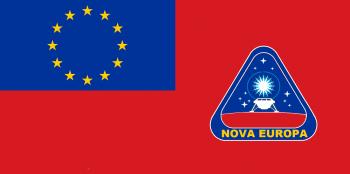 Image from NK_Ryzov, adapted by Arik | |
| Very early European Union colony flag | |
| Planetary Surface | As the first planet colonized in terragen space, Mars hosts an array of ancient settlements which, besides the capital of Olympia, includes Robinson, Xianhongshan, Labyrinth City, Chaos, Tharsis, Mariner City, Ius, Tithonius, Coprates, New Cydonia City, Aresopolis and Lucky Strike along with newer cities such as Zephyria, Hellas Ocean Arcology, and Airy-0. Having been partially terraformed for thousands of years, the Martian atmosphere, while containing too much carbon dioxide for baseline humans, supports a wide variety of tweaked flora and fauna. Martian society is largely conservative, with many restrictions regarding new construction and embodied population growth. As such only 5.3 billion embodied sophonts, nearly all Martian tweaks, live permanently on the surface. Being geologically inactive, Mars makes considerable use of underground habitation with much of the population living within spacious, artificially lit caverns. This leaves large sections of the Martian countryside as either uninhabited wilderness or agricultural fields farmed by bots. Orbital Space: Mars is currently serviced by nine beanstalks. The most used connects the re-positioned remnants of Mar's moon Demios, now known simply as Aerostat Terminus Alpha, to Juventae Bay on the surface. Martian orbital space has several constellations of large habitats arranged at various altitudes. One of the best known of these habitats is Ezekiel's Wheel, a Stanford torus and an important center for various Jewish sects. Another station of note is Biston which houses an impressive array of museum ships. Many habitats are composed entirely of banks of computronium for sophtwares, most of which are uploads of past Martian citizens. These uploads account for the vast majority of the Martian Republic's population. |
|---|---|
| Immigration and Emigration: | Surface: minimal Orbitals: about 5 million per annum Government: Martian Republic, a parliamentary cyberdemocracy whose principle organ is the Senate; composed of 139 administrative districts; member of the Solar Organization. National Holidays: Landing Day, Declaration of Republic, Anniversary of Resettlement, Red Day, Green Day, Blue Day Constitution: Republic Legal system: Conforms to all Solar Organisation Standards Foreign Policy: Member Polity of the The Solar Organisation. Close Trade, Cultural and Ideological links with other member states |
 Image from Phil B | |
| Blue Mars in 10600 A.T. Despite the slightly low atmospheric pressure, the scale height of the atmosphere is quite high, and affords a reasonably good shield against stray cosmic rays. | |
| Economics, Local Infrastructure | Economy: free market with some controlled aspects Currency: Red Dollar Major Industries: agriculture, high tech goods, robotics, edutainment Angelnetting : in some orbitals and cities Major Orbitals: Population Centers(Surface): Major settlements include Robinson (site of the first manned base and former capital of the Martian Republic), Xianhongshan (Scarlet Mountain), the present capital Olympia (with breathtaking views of nearby Olympus Mons), Labyrinth City (in the Noctis Labyrinthus), Chaos, Tharsis, Mariner City (in the Valles Marineris), Ius, Tithonius, Coprates, New Cydonia City, Aresopolis and Lucky Strike. New cities in the SolOrg period include Zephyria and Airy-0. |
|---|---|
| Travel | Major Spaceports: Areostat Terminus on the Martian Beanstalk Beanstalks : One- descends from a repositioned Deimos to Fons Juventae Hazard Rating : orbital 0.0 to 0.2; surface 0.1 to 3.5 Visa Restrictions: Two to three month waiting period for a surface visa; this period can be considerably shortened if one has the right contacts and/or can find a bribeable official. Freedom of Movement: Some family estates and ranches are invitation-only. Environmental Requirements: Respirator or oxygenator nano generally required for non Martian-tweak on the surface Sites of Interest: Spirit and Opportunity heritage museums |
A Martian Tweak of the Pre-Technocalypse Era | |
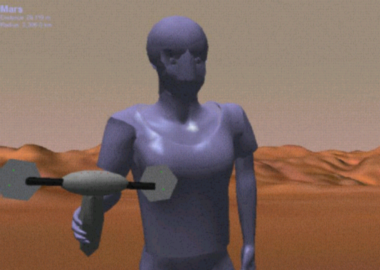 Image from Steve Bowers | |
| An early Martian tweak, adapted to very low pressure environments (these tweaks did not remain on the planet once the atmosphere of Mars passed 100 millibars), and members of this clade have migrated to many locations in the Terragen Sphere since this time, particularly New Mars | |
A Martian Tweak of the Current Era | |
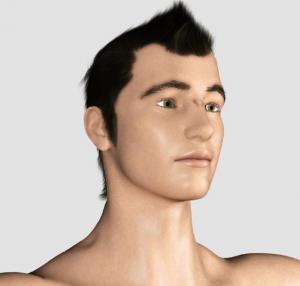 Image from Phil B | |
| A Martian tweak from the current era, adapted to the atmospheric conditions that exist on Blue Mars. These tweaks are tolerant of the high levels of carbon dioxide and low nitrogen levels found on this world. Additional nostrils at the top of the nose allow the tweak to breathe in and out in a cyclic fashion, absorbing oxygen more efficiently especially at altitude. | |
Mars: the Red, Brown and Green World
The first planet outside Earth and Luna to host a permanent occupancy, and for a while the greatest superpower the Solar System has seen, Mars retains a romantic air even to this day. Mars was colonised in the Early Interplanetary Age, and the process of terraforming was started soon after. But it turned out to be much more difficult than first thought; the regolith was salty, and sulphurous; there was little water, and economically important metal ores were relatively rare. The Technocalypse severely damaged the original terraforming program, and Mars never recaptured the glory of the Interplanetary Age.After a brief economic, political, and cultural renaissance during the First Federation era (there was talk of shifting the Federation Capital from Vesta to Robinson), the world suffered a series of drastic ecological crises. Apparently some of the biotic nanites from the original technocalypse had exchanged genetic material with local terraforming micro-organisms. The organisms thus produced remained harmless for many centuries, until they were accidentally hybridised with some new Genen bugs. This in turn triggered a major economic depression that brought down the economy.
During the Expansion era most of the population resettled in orbital biospheres or out-system (New Mars was a popular destination for the old tweak clades, who already had clan and family links, while the baselines preferred Ajarran's World, New Europe, and Michelson).
After the establishment of the Solar Organisation Mars became one of the two most important worlds in the Solar System, together with Luna. From 7544-8600 c.e. Mars was the capital of the SolOrg, and new cities were built in the outback; Zephyria and Airy-0 remain populous and distinctive centres. Mars experienced a second golden age at this time, but it lasted barely a thousand years. Today Mars remains a fairly sparsely populated planet, inhabited by the proud Martians and the large settlements of The Realigned Temples of Humanity.
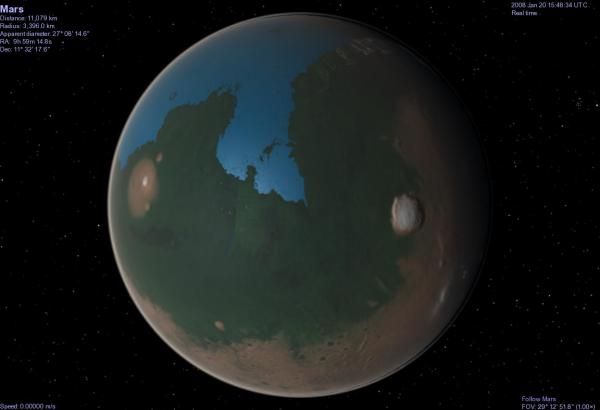 Image from Steve Bowers | |
| Brown Mars in 2390 c.e.: with a surface pressure of 200 millibars and rising, the planet could support dark green, genetically engineered plants which produced oxygen | |
Martian Timeline | |
| 5 b.t. | Red Mars: Mariner 4 - first successful Mars Flyby |
|---|---|
| 6 a.t. | Viking 1 and 2 - Mars Orbiter and Lander |
| 27 a.t. | Mars Global Surveyor / Mars Pathfinder |
| 35 a.t | Mars Rovers Spirit and Opportunity |
| 68 a.t. | Mars mission vessels Discovery and Endeavour depart Earth for Mars. (August 2037 c.e.) |
| 69 a.t. | Ships arrive at Mars. Teams are landed at Isidis and Chryse. (March 2038) |
| 70 | Martian Pioneers arrive back at Earth (May 2040). Space exploration reverts once again to unmanned probes |
| 94 | Second Mars expedition, this time using magbeam boosting systems to reduce trip time to 90 days each direction. A crew of 50 makes the journey to the red planet. The first Mars base is established, with 10 members of the expedition staying behind to begin exploration and research until the next transport vessel arrives to relieve them and rotate in the next crew of 25 explorers. |
| 154 | The largest settlement on Mars is 'Port Robinson', named after information age fabulist and visionary Kim Stanley Robinson who envisaged and described the colonisation and terraforming of Mars. (Not, as is sometimes claimed, after an even earlier tale of a marooned Swiss or Space (details of nationalities differ) Family Robinson). Population 1000 |
| 165 | Discovery of the 'Weeping Wall' of Satori Crater, Planitia, Mars. |
| 168 | Discovery that, as theorised, Mars possessed a crustal environment suitable for BioGeoComputing, but is empty of life. The Mars Development Corporation (MDC) begins experiments towards the creation of a Martian BioGeoComputing (BGC) ecosystem of chemosynthetic bacteria. |
| 185 | Martian Space Elevator completed, allowing easy access to and from the surface |
| 195 | The Aldrin cycler Valparaiso is launched towards Mars, a journey it will continue to make for more than 250 years. |
| 196 | The first of a series of comets is diverted to impact on Mars. |
| 203 | The baseline inhabitants are complemented by a genetically altered group specially tweaked to survive in a Martian-type environment with minimal assistance, although many of the alterations doom them to an unnaturally short life span (this was later rectified through medical bionano and further genome tinkering). |
| 210 | Deep Space Development Corporation uses nuclear charges to nudge an asteroid into a very eccentric orbit that will take it back and forth from near the Earth and out to Mars. Over the next half decade the asteroid is hollowed out, converted it into a habitat and named it Odyssey Transfer Station. |
| 215 | The Inner Council is formed to provide a legal template for new colonies and space usage rights in the inner solar system. Most of the various Martian settlements are founded by one of the Inner Council members. |
| 221 | Neogen species discovered in Martian atmosphere, allegedly gengineered for the terraforming program. Gengineering is now mainstream, but many are uneasy about neogengineering so this causes a bit of a stir. A law is hastily passed by the Inner Council banning several neogen species throughout the inner system (in which the council still has power). Regulations on specific areas of neogen research are also established. |
| 233 | Allegorical date of mythical Mars/Cisluna war (more here) |
| 251 | Serious tensions between the Martian normals and cyborgs who wish to continue terraforming, and the Mars tweaks who will find themselves in an environment they can no longer survive. Alliance between Mars tweaks and a baseline minority called the 'reds' (eco-activists), both of which wish to retain the original Mars for different reasons, results in several minor acts of sabotage. |
| 266 | Surface pressure 60 millibars. Continued small asteroid and comet impacts to raise temperature and increase water content. Gengineered microbes are thriving. |
| All dates in the After Tranquility calendar | |
Image from Anders Sandberg | |
| Comet impact 21600123-5 striking Hellas Planitia, the designated main target area on the southern hemisphere of Mars. The constant stream of ice packages from the outer system striking Mars at regular intervals did not cause much problems for near-planet traffic control and did in fact keep the Mars alliances well supplied with volatiles for their orbital habitats. Only a handful of accidents did occur, the most serious when 22070712-1 hit a settlement in the Terra Tyrrhena after an unexpected very strong outgassing a few minutes before impact. | |
| 281 | Mars is well on the way to being transformed through terraforming. Previously a glacial desert, through nuclear detonations in the crust and beneath the poles the albedo has been lowered and water vapor has been freed. Kuiper belt ice is being imported and gengineered microbes are being used to make the planet livable for unprotected humans, a project expected to take at least two centuries more. |
|---|---|
| 288 | The Lagrange Magshield is deployed, an artificial magnetosphere which protects Mars and its atmosphere against the solar wind. |
| 331 | Surface pressure 150 millibars. At this time Mars is the most populous colony planet, with a population of 90 million humans. It is formally divided into 24 independent regions, each having a seat on the planetary council (which mainly manages the terraforming effort). The council convenes in the new capital at Phobos City. |
| 381 | Brown Mars - Many of the Mars tweaks have long since departed for the Belt and Oort cloud. Population of Mars (through migration and natural population increase) has reached 600 million. Most of the big megacorporations have shifted their base of operations here. Surface pressure 180 millibars. |
| 431 | Port Robinson is now the hub of a vast city that rivals even the huge cities of 'Luna Tyco' and New York, supporting over one hundred million of the best and most idealistic of the Terran peoples, it is considered the gateway to the outer planets and has a huge spaceport to support it. |
| 481 | Surface pressure 220 millibars. While the atmosphere is still too thin for baselines, many of the population is tweaked or bioborged to cope with it, and for those who aren't, most of the cities are still pressurised. The planet is already suffering some pollution from the industry established here, although this is ably dealt with by nanotech. Population two billion, chiefly in the big megapoli like Robinson Central Complex, Phobos City, and Cydonia City. Strict immigration policy prevents newcomers to the promised land. |
| 541 | The Technocalypse in the Solar System reaches Mars. The first artificial plagues strike the red planet. Widespread panic. However local blue goo defences hold. |
| 542 | Violence erupts on and around Mars as the bots of the Nanoswarms wreck the terraforming and kill over 50% of the population. De-orbited satellites and redirected terraforming comets cause serious geological damage. |
| 610 | The remaining Martian ecosystem crashes. Great loss of life, although some refugees escape to surviving orbitals, others to the Belt or the outer solar system. The swarm-ravaged Mars is occupied by Titanite invaders for nearly four decades. |
| 648 | Mars' orbital habitats hold millions of refugees from the planetary surface, and from Earth; shortages of food and overcrowding cause severe social problems for more than two centuries. The Titanite occupation of Mars ends. For more than a hundred years the Red Planet is almost completely empty of inhabitants. |
| circa 781 | AI-designed blue goo reaches Mars and begins cleaning up the planet. |
| 881 | Recolonisation of Mars begins. |
| 1041 | Mars is opened for unrestricted settlement by biologicals, provided they have the necessary augments. |
| 1081 | Resettlement of Mars, terraforming begins anew, various gengineered biota introduced. |
| 1230 | In terms of status and prestige, Mars is once again the greatest world in the Solar System. The First Martian Golden Age. The capital is now Olympus City. |
| 1281 | Surface pressure 300 millibars. Mars has an almost earth-type atmosphere and oceans, although the terraforming is not yet complete. |
| 1521 | Surface pressure 500 millibars. Unexpected bionanogoo resulting from hybridisation of dormant bionano from the original technocalypse accidentally hybridised with new Genen microbes trigger a number of drastic ecological crises, resulting in a major economic depression that brings down the economy. |
| 1700 | Widespread off-planet migration. |
| 3531 | Green Mars: Surface pressure 600 millibars. Remaining Martians once again vote to reject plans to finish terraforming the planet. |
| 3731 | Authenticity purges; many extrasolar species of nearbaseline humanity are expelled from Mars. This leads to the Authenticity war. |
| 4452 | New Martian Federation established; a totalitarian regime based on surveillance and memetic control. Mars goes into another decline and the population drops once more. |
| 4653 | End of the Version War; refugees from New Mars and other mars-like worlds are drawn to the old red planet. |
| 4981 | The influx of refugees leads to a more cosmopolitan society; the 'New Federation' is dissolved. |
| 5301 | Human supremacist groups attack Earth with some support from Martian factions; retaliation by GAIA results in a war in the Solar System, with loss of millions of lives on Mars |
| 5575 | Blue Mars: 700 millibars. The atmosphere has considerably less nitrogen and considerably more carbon dioxide than the atmosphere of Old Earth; unmodified baseline humans still need to use breathing apparatus or biotech adaptations to avoid CO2 poisoning. The partial pressure of oxygen on Mars is, on the other hand, comparable to that of Earth. Mars becomes capital of the Solar Organisation; this period is sometimes called the Second Golden Age. |
| 6631 | Mars Republic secedes from the Solar Organisation for two hundred years; when it returns it is a relatively junior partner. |
| 7731 | The Realigned Temples of Humanity are established, drawing together many disparate groups of humanocentrics and Back-to-Earth activists. |
| 9000s | Mars becomes a major centre for virtual tourism to Earth; many visitors to the Solar System cannot gain access to the Mother Planet, so they take the next best option; a simulated tour of Earth's surface created from almost-real-time information |
For more details about Mars in the Current Era, see here.
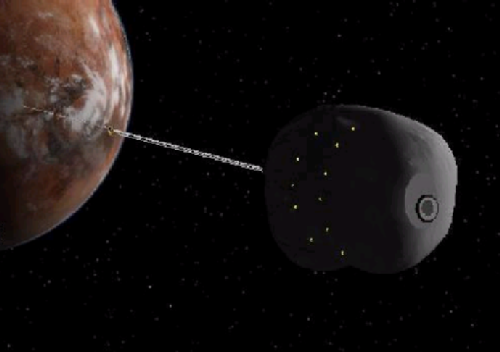 Image from Steve Bowers | |
| The Deimos anchorweight keeps the Martian Elevator in tension | |
 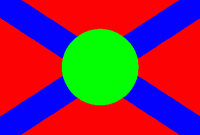 Images from Tony Jones | |
| Note on Martian flags. As with many modosophont polities, Mars has seen a lot of changes in ten thousand years of history. This is reflected also in the many changes in the planetary flag, of which there have been at least a dozen. The original Mars flag (above left) was changed during the reconstruction during the First Federation, got changed back during the authenticist purges of the 3500's, and then was changed back after the Authenticity War. The flag at the right represents the 'New Federation' from 4452 to 4981. Today the old flag is still used by some ultra-orthodox Martians. | |
Related Articles
Appears in Topics
Development Notes
Text by M. Alan Kazlev, MacGregor, Curtis Moore, Anders Sandberg, Tony Jones, Steve Bowers and Damon Court.
Initially published on 10 June 2000.
Traveller's Notes - Mars
Initially published on 10 June 2000.
Stories about Mars
The Great Martian CaperTraveller's Notes - Mars
Additional Information
.
